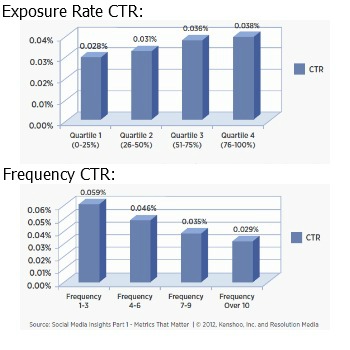Social Metrics to Watch: Exposure and Frequency

 Advertising on Facebook is currently a hot topic due to GM's public pulling of its ads from the social network, which led many marketers to wonder if advertising on the social site is a smart move.
Advertising on Facebook is currently a hot topic due to GM's public pulling of its ads from the social network, which led many marketers to wonder if advertising on the social site is a smart move.
After a year-long study, Resolution Media and Kenshoo are providing marketers with insights on the effectiveness of Facebook ads. The companies analyzed global data spanning 65 billion Facebook ad impressions and 20 million Facebook ad clicks over a wide range of brands and categories - including entertainment, finance, retail and insurance.
"Social media has quickly become one of the preferred channels for brands, and when done right, can foster meaningful relationships between brands and consumers in ways that were never before possible," says Alan Osetek, president of Resolution Media. "The purpose of this study was to define what 'doing it right' means in terms of measureable actions and outcomes, and giving marketers a model for demonstrating effectiveness."
The study reveals that Sponsored Stories and Post Ads receive about double the click-through rate (CTR) of Social and Web Ads, which means that ads with social context resonate better with audience members likely due to a personal connection. Additionally, Post Ads are prone to draw more attention because they often feature special offers and are larger than normal ads.
The data also shows that higher CTR leads to lower average cost-per-click (CPC) rates, with Post Ads averaging a CPC of $0.24, Sponsored Stories averaging $0.46, Web Ads averaging $0.59 and Social Ads averaging the highest CPC at $0.78. But for advertisers that choose the cost-per-thousand (CPM) model, Sponsored Stories are the most expensive ad type - averaging a CPM of $0.31 compared to Web Ads that averaged the lowest CPM of $0.18.
 However, some of the most interesting insights of the study regarded a new metric called "Exposure Rate," which measures targeted engagement on Facebook. This metric determines the percentage of the target audience that a brand is reaching and exposing its message to. The study reveals that high exposure rates correlate to high CTR and conversion rates, with the ads that reached 76-100 percent of their intended audience also receiving an average CTR of .038 percent and conversion rate of 31.92 percent. In comparison, ads that only reached 0-25 percent of the intended audience resulted in an average CTR of 0.028 percent and a conversion rate of 11.81 percent.
However, some of the most interesting insights of the study regarded a new metric called "Exposure Rate," which measures targeted engagement on Facebook. This metric determines the percentage of the target audience that a brand is reaching and exposing its message to. The study reveals that high exposure rates correlate to high CTR and conversion rates, with the ads that reached 76-100 percent of their intended audience also receiving an average CTR of .038 percent and conversion rate of 31.92 percent. In comparison, ads that only reached 0-25 percent of the intended audience resulted in an average CTR of 0.028 percent and a conversion rate of 11.81 percent.
But the study also notes that high exposure rates don't guarantee success, because brands should balance this metric with frequency, which is the amount of times the average Facebook user has been exposed to a specific advertisement. The data from the study shows that there is a conversion rate drop-off of 32 percent when ads are shown to consumers more than six times. This means that the ad is being exposed to the user too frequently, which results in consumers ignoring it. Additionally, the CTR averaged 39 percent lower after the sixth impression.
According to the study, one way that marketers can optimize exposure rate and frequency is by maintaining a CPC above the maximum recommended bid. This is because the study's data showed that the exposure rate was higher for ads with CPCs that were greater than the maximum recommended bid, driving the average exposure rate up by 11.5 percent. Additionally, the data showed that frequency dropped when the CPC was above the maximum recommended bid, by an average of 1.7 exposures.
"With new channels and ad formats come new tracking capabilities," says Sivan Metzger, general manager of Kenshoo Social. "And with new tracking capabilities come new data points. With new data points come new insights. And with new insights come new key performance indicators. This study is the first in a series from Kenshoo and Resolution Media to surface KPIs and help brands define a new measurement paradigm for improved social media investments."

Subscribe to Our Newsletter!
Latest in Social Media









